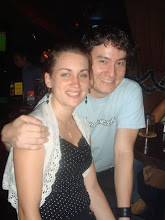After a long trip it was great to snuggle up to a warm fire. We were staying with Anita and Arne, parents of our good friend Zubin back in Melbourne. Arne, a Norweigan diplomat and Anita, a world-renowed journalist were a wealth of information on loads of interesting world topics. Each day we spent hours and hours over dinner or breakfast talking about politics, geography, history, language, culture and everything in between!
On top of that they were amazing hosts and fed us scrumptious home-cooked, tummy-filling meals.
Oh, it was good to be in Oslo!
Anita and Arne's lovely suburban cottage
Happy to be in Norway!
Arne insisted that we sample some local Norweigan delights...
Goat cheese!
Norweigan vodka. Amazingly this vodka is bottled and distilled in Norway, then shipped across the globe to Australia (rolling apparently), then back to Norway, so that it crosses the equator twice!
Prawns on bread.
Cod liver oil, not so delightful - but apparently good for one's health!
Oslo is a lovely little city in Southeastern Norway. One of the smallest capitals of Europe with about 550,000 inhabitants, it is the third largest city in Scandinavia after Stockholm and Copenhagen (not counting Helsinki - which is technically not part of Scandinavia).
Norway has had a turbulent history. From vikings to Danish and Swedish rule, it has constantly been squabbled over. Norway really only became an independent country again in 1905 when it peacefully seperated from Sweden. Public opinion favoured a monarchy so a Danish prince (Prince Carl of Denmark and Iceland) was crowned King of Norway (he took the name Haakon VII in favour of the Norweigan kings of old). Peace in Norway was relatively short-lived when it was invaded by Germany in WWII. Because the monarch was actually Danish, a famous speech by the king urging his fellow Norweigans to stand up against the Germans, was delivered in Danish and broadcast across Norweigan radio. These days his grandson is king and lives a quiet unnasuming life.
Olso today is a compact city with plenty of attractions. Norway's economic and social welfare reforms over the last 4 decades has made Norway one of the richest countries in the world per capita and Oslo arguably the most expensive city on earth, especially for the humble backpacker.
An Oslo tram 

Candice in the gardens of Slottsparken, the Royal Palace.
A Norweigan Royal Guard at Slottsparken
View of the main street from the Royal Palace
Slottsparken
We spent a lot of time walking around Oslo.
Us exploring Oslo
Oslo is an extremely modern city interspersed with older buildings here and there. It lacks the great "imperial capital" feel of both Stockholm and Copenhagen and in a strange way reminded us of Hobart, Australia's southernmost capital city - and probably as far as you can get from Oslo on this planet.
The Oslo skyline
Oslo University
The National Theater
There was a breast cancer awareness march in the city that day
A drop-in church

Candice couldn't resist the long lolly sticks
The modern side of Oslo
Despite the hefty price tag for many of Oslo's attractions, there are some cheap pearlers! The Oslo National Museum is run by the university and was free. It showcased some great samples of artifacts of antiquity from around the globe.
An ancient Ethiopian Coptic Christian bible

A 4000 year old (middle dynasty) Egyptian mummy, so well-preserved you can still see the skin and hair!
Me (Nat) and a dead reindeer
We also made it to the National Art Gallery which houses the world's best collection of Edvard Munch paintings. Best of all, it too was free to visit. Unfortunately we were not able to take photos inside.
For visitors to Oslo, we recommend this free museum over the Munch Museum as it actually has a better selection of his art - including The Scream (1893).
The National Art Gallery
We sampled McDonald's in Oslo. We couldn't even afford a normal meal here - they are seriously the most expensive we've ever seen. Between $25 and $30 for a meal!
World's most expensive Maccas?
Candice all rugged up

The Oslo harbour
We walked to Frognerparken (or Frogner Park in English) which is part of the Frogner manor. It used to belong to rich families in the 19th century, before being aquired by the city of Oslo.
View of Frognerparken from its gates
Frognerparken is famous for housing the Vigeland Sculpture Park, created by Gustav Vigeland during the first half of the 20th century. The massive works represent various ages, moods and stages in lives of people. It culminates in the "Monolith", with its 121 figures struggling to reach the top.



Some of the weird naked figures in Frognerparken
The Monolith
View of Oslo from Frognerparken
Late afternoon in Frognerparken
Further exploration revealed that Oslo is a cosmopolitan city with plenty of chic places to go.
Inner suburban Oslo

Us at the museum
Next we visited the Fram Museum. This houses the famous Fram ship, built in the late 1800s. It is the strongest wooden ship ever built and was used in two Arctic expeditions and also in the famous expedition of Roald Amundsen in 1911 which was the first to reach the South Pole in Antarctica.


The Oslo metro


End of the metro line at Frogneseteren - unfortunately the lovely view of Oslo was obscured by fog and rain.
Thus ended our great Scandinavian rail trip. After bidding Arne and Anita a warm goodbye (in a cold city), we took an overnight train all the way back to Uppsala in Sweden. We awoke to dawn breaking out over the beautiful Swedish countryside and prepared to resume our normal lives, at least for the moment, as residents of Sweden.
For more photos of Oslo, visit http://www.facebook.com/album.php?aid=57618&l=aada8&id=681501850 and http://www.facebook.com/album.php?aid=57626&l=341ed&id=681501850















0 comments:
Post a Comment